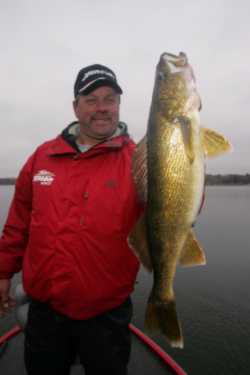|
Give a carpenter a hammer and a level and he or she can
build a mansion. Substitute a crescent wrench and a screwdriver
and the same carpenter would be hard-pressed to construct
a lean-to for the family mutt.
Give a locksmith an inflatable air bladder and a plastic wedge
and he or she can easily retrieve a set of keys left in a
locked vehicle's ignition. Give the same locksmith a screwdriver
and a coat hanger and the task will not only take much longer,
but it will probably leave some minor damage, as well.
I take a similar view when it comes to fishing. Whether it's
late-ice angling across the Upper Midwest or the pursuit of
pre-spawn walleyes on our river systems, the angler who has
the right equipment for the job usually gets the best results.
 |
Sometimes, it's an angler in the ice tent or boat right
next to you who catches fish after fish while you strike
out. Sometimes, it strikes even closer to home and occurs
within your own ice tent or boat.
It may be as simple as using the right line or the right
color and style of jig for the conditions at hand. Or
it may be more an issue of presentation and jigging style
that triggers fish to bite for one angler and not for
another.
As much as I enjoy watching my fishing companions experience
success, it can become frustrating to be the odd man out.
Ice anglers have little margin for error. Winter fish
are lethargic and often fussy. I've watched their behavior
on camera and seen hundreds of fish swim up to a presentation
and simply stare at it before drifting away.
Meanwhile, 10 feet away, another angler is rattling the
bucket with 12-inch crappies, bull bluegills or jumbo
perch. Before we can take into consideration any differences
in baits or presentation, we first need to be certain
we've got the right basic tools for the job. |
Is our line too heavy or is it visible to these finicky fish?
Is it coiled and kinked, thus hampering our ability to detect
bites when fishing with micro ice jigs that might weigh just
a fraction of an ounce when our hands are cold?
I have eliminated those issues by spooling up with clear 2-pound
Yo-Zuri Hybrid Ultra Soft. It's got the sensitivity of fluorocarbon
and the flexibility of nylon with little stretch. It fishes
limp and honest, giving me every chance to see and feel every
bite.
Still missing bites while your neighbor cleans up? The second
piece of equipment I consider essential is a quality spring
bobber.
Many, many "bites" go undetected because the fish
doesn't move after finally taking the bait into its mouth.
It just sits there while it decides whether or not to spit
the bait. Crappies, meanwhile, are notorious for "lift
bites" where they move up as they consume a lure, which
can be nearly impossible to see or feel.
Not much gets past a spring bobber. When I see a fish on my
Lowrance M68 Ice Machine close on my lure, I turn my attention
to my spring bobber. If there's even the slightest change,
set the hook. Very seldom do I ever reel in a lure that's
been stripped of its bait without knowing I had been bit.
Once you're equipped with the right line and spring bobber,
you can turn your attention to lure selection and presentation.
I always have several styles of lures on hand in several colors
and one or two basic sizes.
One thing that can give you an edge is using lures that fish
heavier then their size. In general, smaller is better for
perch and panfish. At the same time, you don't want spring
to arrive while you're trying to get that lure down to a depth
of 20 or 30 feet.
Jigs that feature horizontal-style bodies like Lindy's Genz
Worms and Fat Boys, tick-shaped lures that offer a wider profile
like Lindy Frostees and heads poured with tungsten all fill
this need.
These lures provide more feel for the angler because they
fish heavier than their size, and they get you back into the
strike zone quickly, which is critical when schools of fish
are moving through only periodically.
Sometimes, the thing that matters most is the bait you send
down the hole. Don't limit yourself to one possibility. Try
to arm yourself with a selection that includes minnows, waxworms,
spikes and colored Euro larvae.
Keep a few soft plastics on hand, too. There have been many
times when I've cleaned up using plastics while my partners
have labored to entice fish to commit to the real thing. The
quivering, subtle action of the plastic can make a big difference
at times.
Having the right tools to work with is no less important to
open-water anglers, especially in March when most of the fishing
takes place on rivers in pursuit of walleyes and sauger.
That usually means jigging or slow-trolling live bait or stickbaits,
and that, in turn, means boat control.
While it's important to be prepared for all of these possibilities,
jigging offers the most versatility. You may need to pitch
jigs or drag jigs, but the primary presentation is usually
vertical jigging.
Most anglers know the basic principles -- keep your line as
vertical as possible and never at more than a 45-degree angle.
Establish and be able to maintain contact with the bottom,
then slip downstream along a breakline, current break or hump.
Strong current is often a fact of life. I hit the water with
the confidence that I'll be able to fish effectively all day
long in nearly any condition with my MinnKota 101 bow-mount
and Optima batteries.
Make sure you have the right rod. A 6-foot graphite spinning
rod is good most days, but a 5- or 5 1/2-footer is better
when the wind is blowing, and a 6 1/2- or 7-footer is a good
choice for pitching and casting jigs.
Low-stretch line can separate the successful angler from the
unsuccessful one, as well. I like to know exactly how my jig
is behaving below me, and when used in conjunction with a
quality graphite rod, Yo-Zuri Hybrid makes that possible.
Your choice of jigs is one of the most important decisions
you must make. Few things are more frustrating than watching
somebody hammer the fish because they have a jig you can't
duplicate.
Fortunately, the old lead-head is an easily adapted and relatively
inexpensive bait that can be stocked in a variety of sizes,
colors and styles, although all jigs are not created equal.
First and foremost, I want a jig with a wide gap. When quality
walleye and sauger decide to eat, they don't usually miss
their target. They eat by flaring their gills and creating
a vaccuum that draws the prey into their mouths.
So, whether I'm fishing vertically or pitching jigs, there's
no reason not to use jigs with large, wide-gapped hooks. I
carry sizes ranging from 1/8th-ounce to 3/8th-ounce for my
spring river outings.
The other advantage of Max Gap jigs is that they can be tipped
with either live bait or plastic for two entirely different
looks.
When it comes to vertical jigging, you'll want to add a few
bucktail or hair jigs, a couple of current-cutting and stand-up
head styles and some larger sizes up to one ounce for extreme
conditions.
As for colors, I stock an assortment, but I carry more lighter
shades that can be changed quickly, when necessary, with a
few strokes from a permanent marker. Flash tape and stick-on
eyes are other accessories that can make a difference.
Finally, don't leave home without a dozen or so stinger hooks.
Finicky walleye and sauger are sometimes unwilling to commit
to a jig. Instead, they only nip at it as it passes by. The
angler equipped with stinger hooks stands a much greater chance
of hooking up with some of those fish.
Most of us would never try to eat soup with a fork or tow
a boat with a moped, although we might eventually get the
job done.
It makes far more sense to equip ourselves with the tools
of the trade.
|

